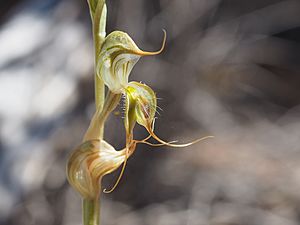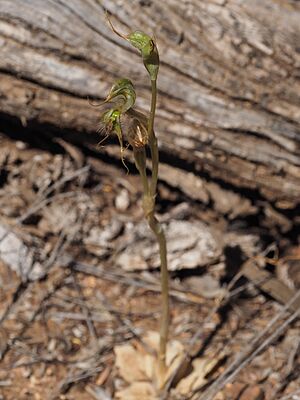Rufous greenhood facts for kids
Quick facts for kids Rufous greenhood |
|
|---|---|
 |
|
| Pterostylis roensis, east of Kondinin | |
| Scientific classification | |
| Genus: |
Pterostylis
|
| Species: |
roensis
|
| Synonyms | |
|
Oligochaetochilus roensis (M.A.Clem.) Szlach. |
|
The Pterostylis roensis, often called the painted rufous greenhood or dark rustyhood, is a special plant from the orchid family. It grows only in the south-west part of Western Australia. Both young plants and those ready to flower have a group of leaves that form a rosette, which looks like a circular pattern. When the plant flowers, it can have up to six green, brown, or blackish flowers. These flowers have clear white sections and a dark brown, thick part called a labellum that looks like an insect.
Contents
What Does the Rufous Greenhood Look Like?
The Rufous greenhood (Pterostylis roensis) is a plant that grows from the ground. It is a perennial herb, meaning it lives for more than two years. It has an underground tuber (a swollen stem that stores food) and a rosette of six to eleven leaves. These leaves are about 15 to 45 mm (0.6 to 1.8 in) long and 5 to 18 mm (0.2 to 0.7 in) wide.
When the plant flowers, it has a rosette of leaves at the bottom of its stem. However, these leaves usually dry up by the time the flowers appear. The plant can grow up to six flowers on a stem that is 150 to 300 mm (6 to 12 in) tall. The flowers are green, brown, or blackish, with clear white areas. Each flower is about 24 to 27 mm (0.9 to 1.1 in) long and 6 to 9 mm (0.2 to 0.4 in) wide.
The top part of the flower, called the "galea" or hood, is made from the sepals and petals. This hood covers the central part of the flower. The top sepal has a narrow tip that is 3 to 5 mm (0.1 to 0.2 in) long. The side sepals point downwards and are about the same width as the hood. They narrow suddenly into tips that are 6 to 10 mm (0.2 to 0.4 in) long and spread apart.
The most interesting part is the labellum. It is dark brown, thick, and looks like an insect. It's about 5 mm (0.2 in) long and 2 mm (0.08 in) wide. The "head" end of the labellum has a few short hairs. Along each side of the "body" part, there are six to nine longer bristles. These flowers bloom from September to November.
How the Rufous Greenhood Got Its Name
The Pterostylis roensis was first officially described in 1989. Two botanists, David Jones and Mark Clements, studied a plant found near Norseman. They published their description in a science paper called Australian Orchid Research.
The second part of its scientific name, roensis, comes from the Roe botanical district. This is an area in Western Australia where this type of greenhood orchid is very common.
Where Does the Rufous Greenhood Live?
The Rufous greenhood grows in different types of environments. You can find it in woodlands, areas with shrubs, and in shallow soil on top of granite rocks. It lives in the region between Hyden and Balladonia. This area includes parts of the Avon Wheatbelt, Coolgardie, and Mallee biogeographic regions. These regions are special areas defined by their unique plants and animals.
Is the Rufous Greenhood in Danger?
The Western Australian Government's Department of Parks and Wildlife has looked at the Rufous greenhood. They have classified it as "not threatened." This means that currently, there are enough of these plants, and they are not considered to be at risk of disappearing.


